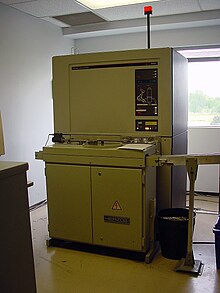
Back فلورية الأشعة السينية Arabic Rentgenová fluorescence Czech Röntgenfluoreszenz German Fluorescencia de rayos X Spanish Röntgenfluorestsents Estonian طیفسنجی فلورسانس پرتو ایکس Persian Fluorescence X French פלואורסצנצית קרני רנטגן HE Rendgenoluminescencija Croatian Fluoresensi sinar-X ID



X-ray fluorescence (XRF) is the emission of characteristic "secondary" (or fluorescent) X-rays from a material that has been excited by being bombarded with high-energy X-rays or gamma rays. The phenomenon is widely used for elemental analysis and chemical analysis, particularly in the investigation of metals, glass, ceramics and building materials, and for research in geochemistry, forensic science, archaeology and art objects[1] such as paintings.[2][3]
- ^ De Viguerie L, Sole VA, Walter P, Multilayers quantitative X-ray fluorescence analysis applied to easel paintings, Anal Bioanal Chem. 2009 Dec; 395(7): 2015-20. doi:10.1007/s00216-009-2997-0
- ^ X-Ray Fluorescence at ColourLex
- ^ Pessanha, Sofia; Queralt, Ignasi; Carvalho, Maria Luísa; Sampaio, Jorge Miguel (1 October 2019). "Determination of gold leaf thickness using X-ray fluorescence spectrometry: Accuracy comparison using analytical methodology and Monte Carlo simulations". Applied Radiation and Isotopes. 152: 6–10. Bibcode:2019AppRI.152....6P. doi:10.1016/j.apradiso.2019.06.014. hdl:10261/206347. ISSN 0969-8043. PMID 31203095. S2CID 189944850.and murals